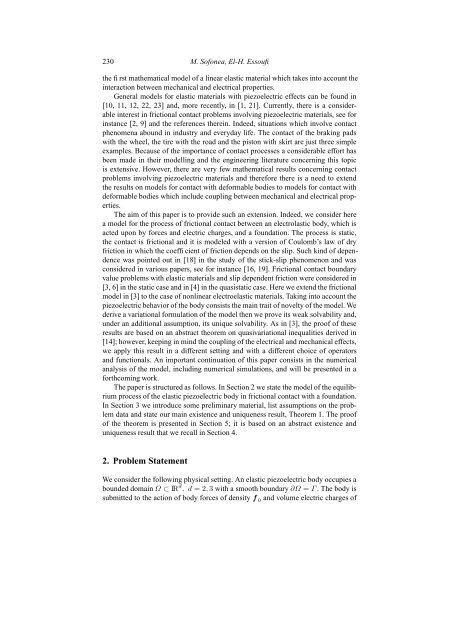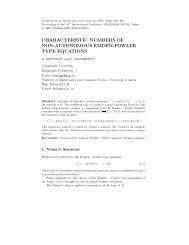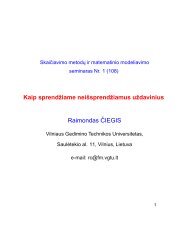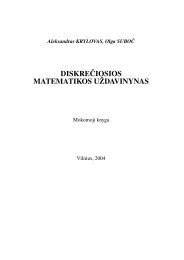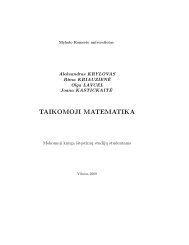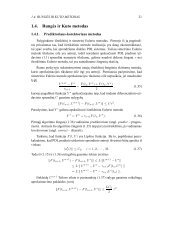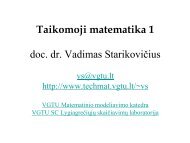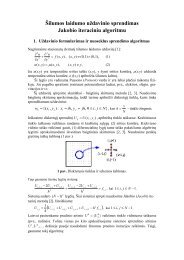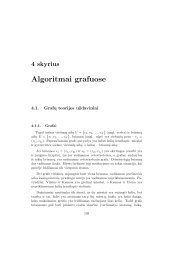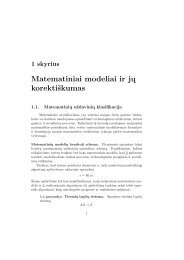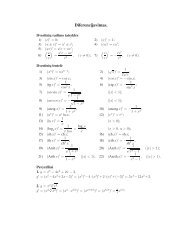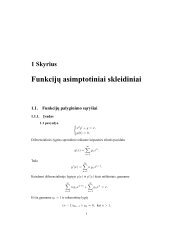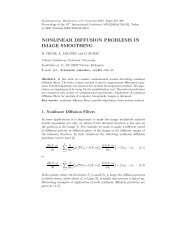a piezoelectric contact problem with slip dependent coefficient of ...
a piezoelectric contact problem with slip dependent coefficient of ...
a piezoelectric contact problem with slip dependent coefficient of ...
You also want an ePaper? Increase the reach of your titles
YUMPU automatically turns print PDFs into web optimized ePapers that Google loves.
230 M. S<strong>of</strong>onea, El-H. Essoufithe first mathematical model <strong>of</strong> a linear elastic material which takes into account theinteraction between mechanical and electrical properties.General models for elastic materials <strong>with</strong> <strong>piezoelectric</strong> effects can be found in[10, 11, 12, 22, 23] and, more recently, in [1, 21]. Currently, there is a considerableinterest in frictional <strong>contact</strong> <strong>problem</strong>s involving <strong>piezoelectric</strong> materials, see forinstance [2, 9] and the references therein. Indeed, situations which involve <strong>contact</strong>phenomena abound in industry and everyday life. The <strong>contact</strong> <strong>of</strong> the braking pads<strong>with</strong> the wheel, the tire <strong>with</strong> the road and the piston <strong>with</strong> skirt are just three simpleexamples. Because <strong>of</strong> the importance <strong>of</strong> <strong>contact</strong> processes a considerable effort hasbeen made in their modelling and the engineering literature concerning this topicis extensive. However, there are very few mathematical results concerning <strong>contact</strong><strong>problem</strong>s involving <strong>piezoelectric</strong> materials and therefore there is a need to extendthe results on models for <strong>contact</strong> <strong>with</strong> deformable bodies to models for <strong>contact</strong> <strong>with</strong>deformable bodies which include coupling between mechanical and electrical properties.The aim <strong>of</strong> this paper is to provide such an extension. Indeed, we consider herea model for the process <strong>of</strong> frictional <strong>contact</strong> between an electrolastic body, which isacted upon by forces and electric charges, and a foundation. The process is static,the <strong>contact</strong> is frictional and it is modeled <strong>with</strong> a version <strong>of</strong> Coulomb’s law <strong>of</strong> dryfriction in which the <strong>coefficient</strong> <strong>of</strong> friction depends on the <strong>slip</strong>. Such kind <strong>of</strong> dependencewas pointed out in [18] in the study <strong>of</strong> the stick-<strong>slip</strong> phenomenon and wasconsidered in various papers, see for instance [16, 19]. Frictional <strong>contact</strong> boundaryvalue <strong>problem</strong>s <strong>with</strong> elastic materials and <strong>slip</strong> <strong>dependent</strong> friction were considered in[3, 6] in the static case and in [4] in the quasistatic case. Here we extend the frictionalmodel in [3] to the case <strong>of</strong> nonlinear electroelastic materials. Taking into account the<strong>piezoelectric</strong> behavior <strong>of</strong> the body consists the main trait <strong>of</strong> novelty <strong>of</strong> the model. Wederive a variational formulation <strong>of</strong> the model then we prove its weak solvability and,under an additional assumption, its unique solvability. As in [3], the pro<strong>of</strong> <strong>of</strong> theseresults are based on an abstract theorem on quasivariational inequalities derived in[14]; however, keeping in mind the coupling <strong>of</strong> the electrical and mechanical effects,we apply this result in a different setting and <strong>with</strong> a different choice <strong>of</strong> operatorsand functionals. An important continuation <strong>of</strong> this paper consists in the numericalanalysis <strong>of</strong> the model, including numerical simulations, and will be presented in aforthcoming work.The paper is structured as follows. In Section 2 we state the model <strong>of</strong> the equilibriumprocess <strong>of</strong> the elastic <strong>piezoelectric</strong> body in frictional <strong>contact</strong> <strong>with</strong> a foundation.In Section 3 we introduce some preliminary material, list assumptions on the <strong>problem</strong>data and state our main existence and uniqueness result, Theorem 1. The pro<strong>of</strong><strong>of</strong> the theorem is presented in Section 5; it is based on an abstract existence anduniqueness result that we recall in Section 4.2. Problem StatementWe consider the following physical setting. An elastic <strong>piezoelectric</strong> body occupies abounded domain Ω ⊂ IR d , d = 2, 3 <strong>with</strong> a smooth boundary ∂Ω = Γ . The body issubmitted to the action <strong>of</strong> body forces <strong>of</strong> density f 0 and volume electric charges <strong>of</strong>


